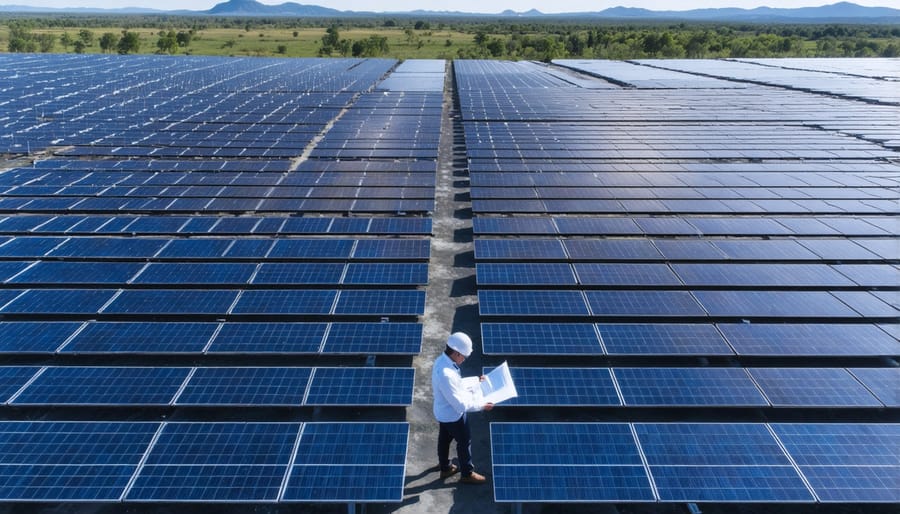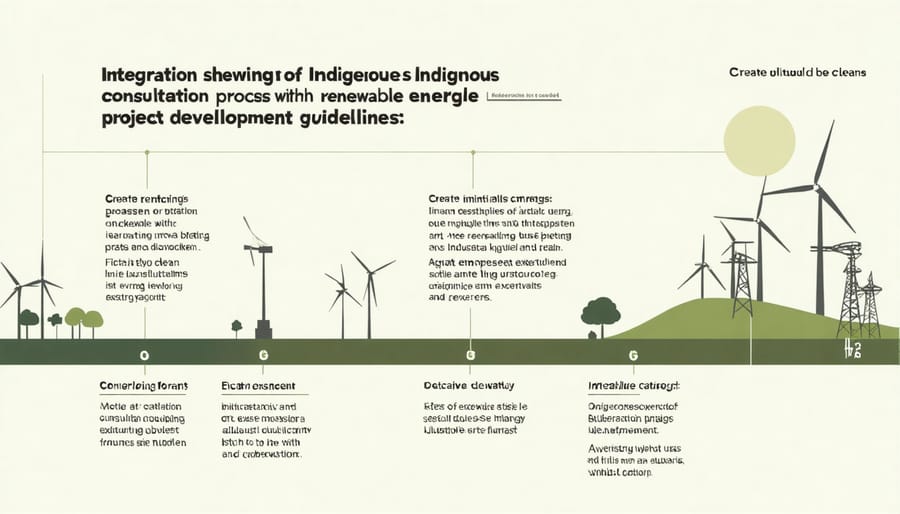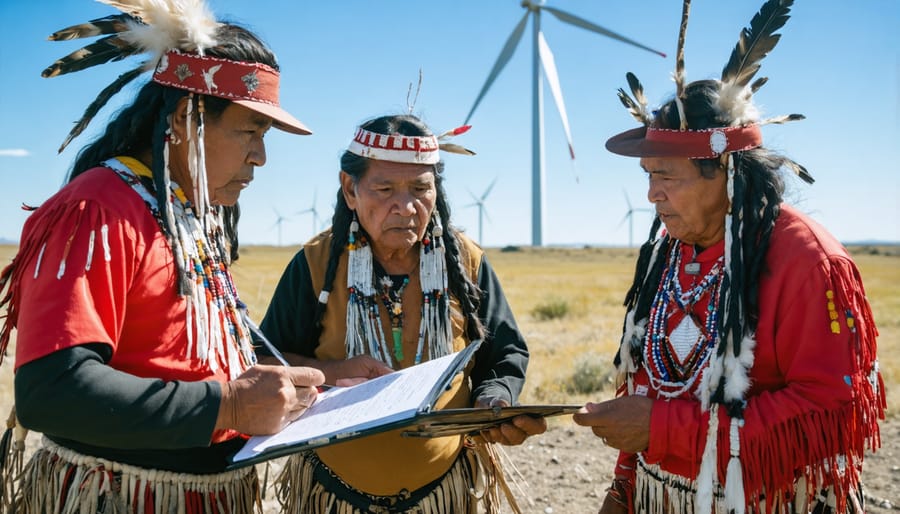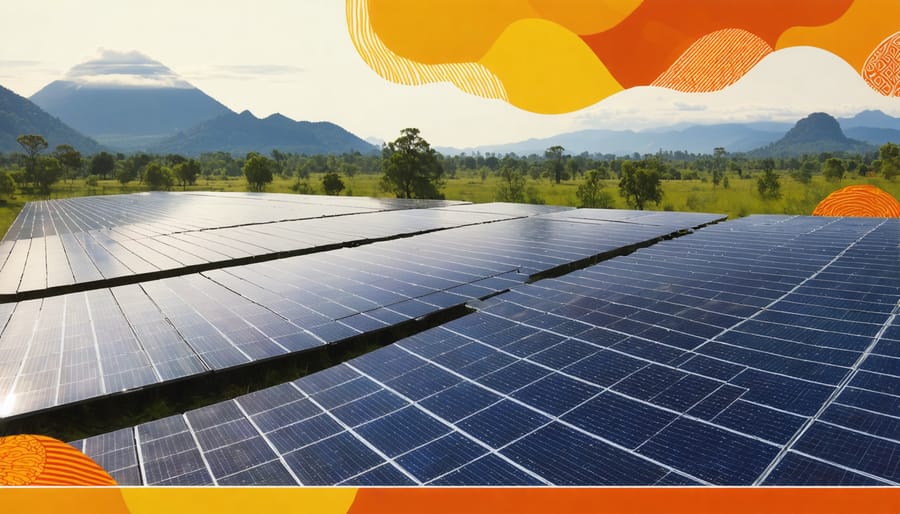The global shift towards Australia’s renewable energy revolution marks a critical turning point in our fight against climate change, yet success hinges on creating inclusive policies that honor Indigenous rights and cultural heritage. Transformative green energy initiatives already demonstrate how traditional knowledge and modern technology can work in harmony, delivering both environmental and social benefits. From solar farms co-managed by Aboriginal communities in the Northern Territory to wind projects that protect sacred sites while powering thousands of homes, Australia stands at the forefront of respectful renewable development. These pioneering approaches prove that sustainable energy transition doesn’t require choosing between progress and cultural preservation – instead, they reveal how Indigenous partnerships strengthen environmental outcomes while creating lasting economic opportunities for traditional custodians of the land. As nations worldwide grapple with urgent climate action, Australia’s emerging framework for collaborative green energy development offers a compelling blueprint for policies that unite technological innovation with ancient wisdom.
Traditional Land Rights and Renewable Energy Development
Native Title Considerations in Energy Projects
Native title considerations form a crucial cornerstone of renewable energy development in Australia, requiring thoughtful engagement with Traditional Owners and respect for Indigenous land rights. The Native Title Act 1993 provides the primary legal framework for protecting Indigenous interests, ensuring that renewable energy projects cannot proceed without proper consultation and agreement with Traditional Owners.
Successful renewable energy projects have demonstrated that early engagement and genuine partnership with Indigenous communities can create mutually beneficial outcomes. For instance, the Kidston Solar Project in North Queensland exemplifies how developers can work alongside Traditional Owners to protect cultural heritage while advancing clean energy goals.
The consultation process typically involves cultural heritage surveys, negotiation of Indigenous Land Use Agreements (ILUAs), and ongoing dialogue throughout the project lifecycle. These agreements often include provisions for employment opportunities, cultural heritage protection, and benefit-sharing arrangements that support Indigenous economic development.
Recent developments have seen Indigenous communities taking active roles in renewable energy projects, not just as stakeholders but as project partners and investors. This shift represents a positive evolution in the relationship between renewable energy developers and Traditional Owners, creating pathways for economic empowerment while respecting cultural connections to Country.
For project developers, understanding and respecting native title rights isn’t just a legal requirement – it’s an opportunity to build lasting partnerships that enhance project outcomes and contribute to reconciliation. This approach ensures that Australia’s transition to renewable energy occurs in a way that honours and benefits all communities.
Success Stories: Indigenous-Led Energy Initiatives
Indigenous communities across Australia are leading the way in renewable energy innovation, demonstrating how traditional knowledge and modern technology can work together for a sustainable future. The Warwick Solar Farm in Queensland, managed by the Gunggari people, stands as a shining example of successful solar energy development that respects cultural heritage while generating clean power for thousands of homes.
In Western Australia, the Kimberley region’s Djarindjin Aboriginal Corporation has implemented an innovative solar-diesel hybrid system, reducing diesel consumption by 80% while providing reliable power to their remote community. This project has created local jobs and developed valuable technical skills within the community.
The Ramahyuck District Aboriginal Corporation in Victoria has transformed unused land into a 75-hectare solar farm, generating enough electricity to power 7,200 homes while providing economic opportunities for Traditional Owners. The project’s success has inspired similar initiatives across the state.
These achievements demonstrate how Indigenous-led energy projects can deliver multiple benefits: environmental sustainability, economic independence, and cultural preservation. The projects showcase effective partnerships between Traditional Owners, government bodies, and energy companies, creating templates for future initiatives that prioritize Indigenous knowledge and leadership in Australia’s renewable energy transition.
Each success story reinforces the importance of Indigenous self-determination in energy policy and highlights how traditional wisdom can enhance modern sustainable practices.

Building Sustainable Partnerships

Community Consultation Best Practices
Meaningful engagement with Indigenous communities is fundamental to developing successful and equitable innovative energy policies. The consultation process should begin early, well before project planning stages, and maintain consistent dialogue throughout the project lifecycle.
First Nations communities should be approached with respect for their traditional decision-making processes and timeframes. This means allowing sufficient time for community members to discuss proposals internally and reach consensus according to their cultural protocols. Establishing a single point of contact within the community can help streamline communication while ensuring all voices are heard.
Documentation and transparency are crucial elements of effective consultation. All meetings, agreements, and concerns should be properly recorded and shared with community stakeholders. This creates a clear trail of communication and helps build trust between project developers and Indigenous communities.
Cultural awareness training for project teams is essential. Understanding the significance of Country, traditional land management practices, and cultural heritage helps create meaningful dialogue and prevents misunderstandings. Consider engaging Indigenous facilitators who can bridge cultural gaps and ensure discussions are culturally appropriate.
Benefit-sharing agreements should be developed collaboratively, focusing on long-term community outcomes rather than short-term gains. This might include employment opportunities, skills training, educational programs, or ongoing revenue sharing arrangements. The key is ensuring these benefits align with community priorities and aspirations.
Regular feedback mechanisms should be established to address concerns promptly and adapt approaches as needed. This demonstrates commitment to genuine partnership and helps maintain positive relationships throughout the project’s duration. Remember that successful consultation is an ongoing process, not a one-time event.
Economic Benefits and Opportunities
Green energy policies are creating unprecedented economic opportunities for Indigenous communities across Australia, transforming traditional lands into hubs of renewable energy innovation. The shift towards sustainable energy has opened new pathways for economic empowerment, with Indigenous-owned solar and wind projects leading the way in community development.
Recent studies show that renewable energy projects in Indigenous territories create three times more long-term jobs compared to fossil fuel initiatives. These positions range from technical roles in installation and maintenance to management positions in project oversight, providing diverse career pathways for community members.
The Warral Solar Farm in Northern Territory serves as a prime example, where local Indigenous communities have partnered with energy developers to create a successful enterprise that generates both clean power and sustainable income. The project has created over 50 permanent positions and established a training program that prepares the next generation of renewable energy professionals.
Beyond direct employment, these initiatives spark broader economic benefits through supply chain opportunities and tourism. Indigenous-owned businesses are increasingly providing services to renewable energy projects, from site maintenance to cultural heritage consulting. Additionally, many communities have developed eco-tourism programs around their renewable energy installations, sharing their sustainable practices with visitors while generating additional revenue streams.
Investment in green energy infrastructure also strengthens community resilience by reducing power costs and creating energy independence. These savings are often reinvested into other community development projects, creating a positive cycle of economic growth and environmental stewardship.
Environmental Stewardship and Cultural Values

Traditional Knowledge in Project Planning
Australia’s journey towards sustainable energy practices has been significantly enriched by incorporating Indigenous traditional knowledge into project planning. For generations, Aboriginal and Torres Strait Islander peoples have maintained a deep understanding of local ecosystems, seasonal patterns, and sustainable resource management.
This valuable knowledge is now being integrated into renewable energy projects across the country, leading to more environmentally sensitive and culturally appropriate developments. In the Kimberley region, for example, solar farm installations have been guided by Indigenous expertise in land management, resulting in minimal disruption to native flora and fauna while maximizing energy generation potential.
Traditional knowledge has proven particularly valuable in identifying suitable locations for wind farms and solar arrays. Indigenous communities’ understanding of weather patterns, migration routes of native species, and sacred cultural sites helps developers avoid environmentally sensitive areas while optimizing project outcomes.
Several successful partnerships between renewable energy companies and Indigenous communities demonstrate the effectiveness of this approach. The Kennedy Energy Park in North Queensland incorporated traditional knowledge in its planning phase, leading to better project outcomes and stronger community support. This collaborative approach not only ensures environmental protection but also creates economic opportunities for Indigenous communities through employment and business partnerships.
The integration of traditional knowledge extends beyond site selection to include ongoing environmental monitoring and maintenance practices, creating a holistic approach to sustainable energy development that respects both cultural heritage and environmental needs.
Cultural Heritage Protection Strategies
Australia’s transition to renewable energy presents a unique opportunity to showcase how cultural heritage protection and green energy development can work in harmony. The successful integration of these elements begins with early consultation and meaningful engagement with Indigenous communities and cultural heritage experts.
Leading renewable energy projects now employ comprehensive cultural mapping before breaking ground. This approach involves working closely with Traditional Owners to identify and document significant sites, songlines, and cultural landscapes. For example, the Cooper Creek Solar Farm project demonstrated excellence in cultural heritage protection by realigning solar panel installations to preserve ancient rock art sites and ceremonial grounds.
Best practice strategies include developing Cultural Heritage Management Plans (CHMPs) that outline clear protocols for site preservation, artifact handling, and ongoing cultural monitoring. These plans often incorporate innovative solutions such as creating buffer zones around sacred sites and using advanced construction techniques that minimize ground disturbance.
Technology plays a crucial role in protection efforts, with developers utilizing 3D mapping and drone surveys to create detailed cultural heritage overlays. These tools help optimize renewable energy infrastructure placement while ensuring minimal impact on cultural sites.
Many successful projects have established Indigenous ranger programs, where Traditional Owners actively participate in site monitoring and maintenance. This approach not only ensures proper cultural site protection but also creates meaningful employment opportunities and strengthens community relationships.
The key to successful cultural heritage protection lies in viewing Indigenous knowledge and cultural preservation not as obstacles but as valuable guides in creating more sustainable and respectful renewable energy developments.
Policy Recommendations for the Future
Legislative Reform Priorities
To effectively protect Indigenous rights in renewable energy development, Australia needs comprehensive energy policy reforms that prioritize meaningful consultation and shared benefits. Key legislative changes should include mandatory Indigenous engagement protocols during project planning phases and requirements for obtaining Free, Prior, and Informed Consent (FPIC) before project commencement.
Reform priorities should focus on establishing clear frameworks for benefit-sharing agreements that ensure Indigenous communities receive fair economic returns from renewable energy projects on their lands. This includes implementing mandatory local employment quotas, training programs, and profit-sharing mechanisms.
Environmental protection measures must incorporate Traditional Ecological Knowledge (TEK) into project assessments and ongoing land management practices. Legislation should require developers to work with Indigenous rangers and cultural heritage experts throughout project lifecycles.
Additionally, reforms should strengthen Indigenous land rights recognition in renewable energy planning, ensuring sacred sites and cultural landscapes are protected. This can be achieved through mandatory cultural heritage surveys and the integration of Indigenous mapping systems into project planning tools.
The creation of an Indigenous Renewable Energy Advisory Board would provide crucial oversight and guidance in policy development, ensuring reforms align with Indigenous perspectives and aspirations for sustainable development.
Implementation Framework
Successful implementation of green energy policies requires a structured approach that actively incorporates Indigenous perspectives from the outset. The framework begins with early engagement through Indigenous-led consultations, ensuring traditional knowledge holders are central to the planning process.
A vital first step is establishing Indigenous Advisory Committees with decision-making authority. These committees should comprise Elders, community leaders, and Indigenous energy experts who can guide policy development while ensuring cultural protocols are respected.
The framework operates on three key pillars: capacity building, benefit-sharing, and cultural heritage protection. Capacity building involves training programs and skills development within Indigenous communities, creating pathways for meaningful participation in renewable energy projects. Benefit-sharing agreements must guarantee fair economic returns and employment opportunities for Indigenous communities.
Implementation should follow a staged approach:
– Initial community mapping and relationship building
– Collaborative project design incorporating traditional knowledge
– Skills and employment program development
– Infrastructure planning with cultural heritage considerations
– Regular review and adjustment of policies based on community feedback
Success requires dedicated funding mechanisms, transparent communication channels, and flexible timelines that accommodate Indigenous decision-making processes. Regular monitoring and evaluation, led by Indigenous representatives, ensures policies remain effective and culturally appropriate while meeting renewable energy targets.
As we’ve explored throughout this discussion, the path to a sustainable energy future requires a carefully balanced approach that considers environmental, economic, and social factors. Australia’s green energy policies have shown promising developments, particularly in areas where community engagement and technological innovation intersect.
The success of renewable energy initiatives depends heavily on finding the sweet spot between ambitious targets and practical implementation. We’ve seen how effective policy frameworks can drive investment in solar, wind, and bioenergy projects while creating jobs and supporting local communities. The transition to renewable energy isn’t just about replacing fossil fuels – it’s about building a more resilient and equitable energy system for all Australians.
Key to this transformation is the recognition that different regions and communities have unique needs and challenges. What works in urban Melbourne may not be suitable for remote communities in the Northern Territory. This understanding has led to the development of flexible policies that can be adapted to local conditions while maintaining consistent national standards.
Looking ahead, the future of green energy in Australia appears bright, but success will require ongoing commitment from all stakeholders. By maintaining focus on innovation, community engagement, and fair transition practices, we can build an energy system that serves both current and future generations. The lessons learned from successful projects across the country demonstrate that with proper planning and inclusive policy-making, renewable energy can deliver environmental benefits while supporting economic growth and social equity.
Remember, the journey to renewable energy is a marathon, not a sprint, and balanced, well-thought-out policies are our best guide forward.

